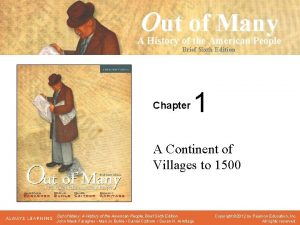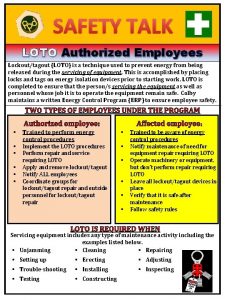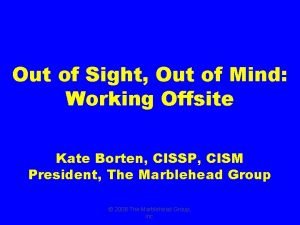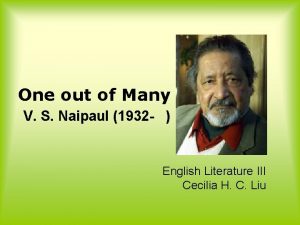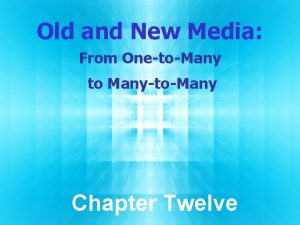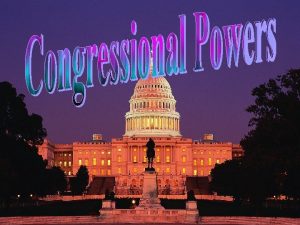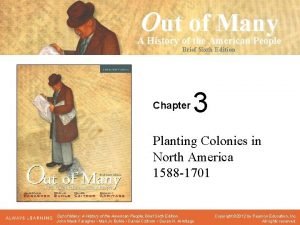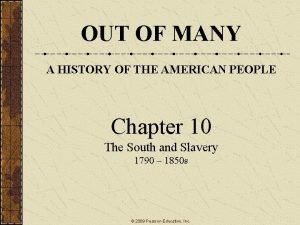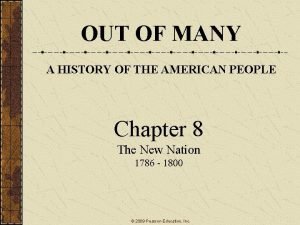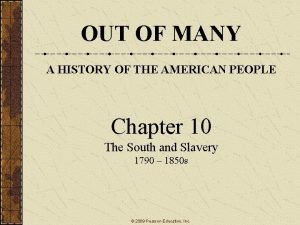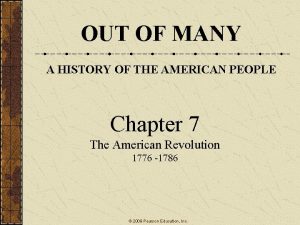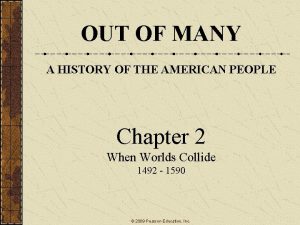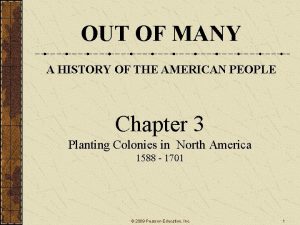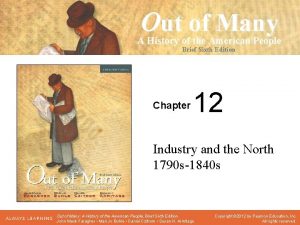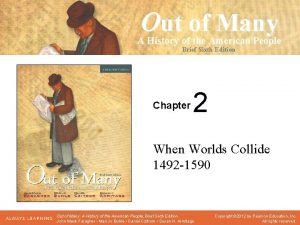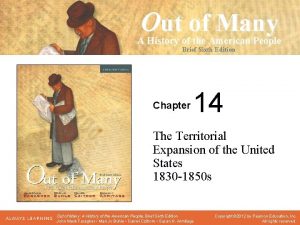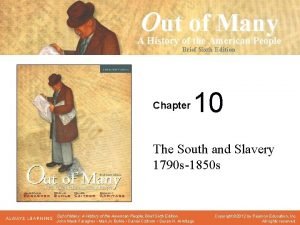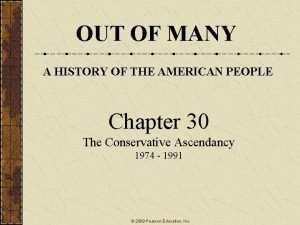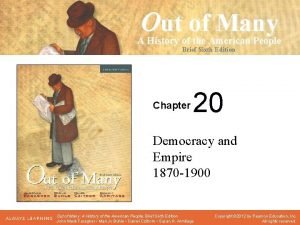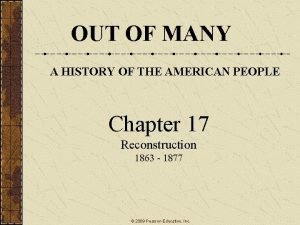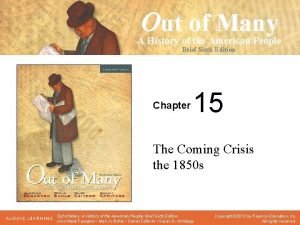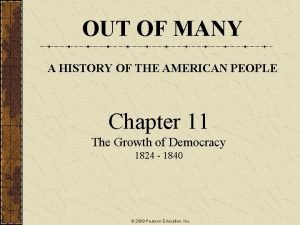Out of Many A History of the American



































































- Slides: 67

Out of Many A History of the American People Seventh Edition Brief Sixth Edition Chapter 13 Meeting the Challenges of the New Age Immigration, Urbanization, Social Reform 1820 s-1850 s Out of Many: A History of the American People, Brief Sixth Edition John Mack Faragher • Mari Jo Buhle • Daniel Czitrom • Susan H. Armitage Copyright © 2012 by Pearson Education, Inc. All rights reserved.

Meeting the Challenges of the New Age Immigration, Urbanization, Social Reform 1820 s-1850 s • • • Immigration and the City Urban Problems Social Reform Movements Antislavery and Abolitionism The Women’s Rights Movement Conclusion

Chapter Focus Questions • What caused the immigration of the 1840 s and 1850 s, and what were responses to it? • Why were cities so unable to cope with rapid urbanization? • What motivated reform movements? • What were the origins and political effects of the abolitionist movement?

Chapter Focus Questions (cont’d) • How were women involved in reform efforts?

North America and Seneca Falls

Women Reformers of Seneca Falls Respond to the Market Revolution • 1848: 300 reformers at Seneca Falls women’s rights convention • Resolutions calling for a wide range of rights for women, including the right to vote • Just one of many reform movements of the time • Many issues of the time raised but few problems solved

Immigration and the City

The Bay and Harbor of New York

FIGURE 13. 1 Urban Growth, 1820– 60

The Growth of Cities • The market revolution dramatically increased the size of the cities. • “Instant” cities sprung up around critical points in the transportation network. • Chicago, San Francisco and St. Louis grew from towns of 5, 000 to cities of 100, 000. • By 1860, 20% of Americans lived in cities.

MAP 13. 1 Distribution of Foreign-Born Residents of the United States in 1860

Patterns of Immigration • Immigration was a key part of urban growth. • Beginning in 1830 immigration soared, particularly in the North. • Immigrants came largely from Ireland Germany.

Patterns of Immigration (cont'd) • Life for immigrants was seldom easy, as cities were unprepared for rapid growth and social challenges of immigrant populations.

1858 engraving of an Irish bar in the Five Points area

Irish Immigration • First major immigrant wave to American cities • 1845 -49: Potato Famine § poor Irish to America • Most lived in cities under miserable conditions

Irish Immigration (cont'd) • Most to New York, but Boston, being smaller in size and more homogenous, was overwhelmed by the influx • Catholic Irish faced major religious persecution.

Cartoon encounter between a newly arrived Irishman and an African American

German Immigration • William Penn in the late 18 th century invited German immigration § impressed by German industriousness • 19 th century started German influx, by 1854 Germans surpassed Irish immigration • Not as poor as Irish and more likely to become farmers

German Immigration (cont'd) • Dispersed settlements (except northeastern cities and the South) • One Southern exception was Texas, where 1830 s Mexican land grants attracted Germans.

The Chinese in California • The Gold Rush and railroad construction brought Chinese immigrants to California. • San Francisco’s Chinatown is the oldest Chinese ethnic enclave in America and a center of community life.

Ethnic Neighborhoods • Almost all new immigrants lived in urban ethnic enclaves. • Ethnic communities provided support for new immigrants as they learned how to survive in new surroundings. • While ethnic communities preserved immigrants’ culture, native-born Americans often viewed ethnic communities with suspicion.

P. T. Barnum’s Famous “Curiosity: ” General Tom Thumb

Urban Problems

The Five Points neighborhood in lower Manhattan

New Living Patterns in the Cities • Pre-industrial cities—small, compact “walking cities” • Immigration transformed urban life • The gap increased between rich and poor in cities • Cities struggled § services such as water, sewerage, garbage collection

New Living Patterns in the Cities (cont'd) • Residential segregation—ethnic neighborhoods and middle class suburbs —increasingly marked cities.

FIGURE 13. 2 Participation of Irish and German Immigrants in the New York City Workforce for Selected Occupations, 1855

Ethnicity in Urban Popular Culture • Irish immigrants faced both job discrimination and cultural denigration. • Gang warfare and urban riots reinforced middle class attitudes toward the Irish. • Minstrel shows and racist characters like Jim Crow reinforced native white prejudices.

The Labor Movement and Urban Politics • Worker associations became increasingly angry regarding their declining social and economic status. • Workers’ associations became increasingly class-conscious turning to fellow laborers for support, forming trades unions and workers’ associations.

The Labor Movement and Urban Politics (cont'd) • Initially, urban worker protest against change focused on party politics, including the short-lived Workingmen’s Party. • Both major parties tried to woo the votes of organized workers. • By the 1850 s, New York City’s Tammany Democratic organization controlled city politics with immigrant support.

Civic Order • The popular press and writers like Whitman and Poe responded to new urban communities with penny papers, poetry and murder mystery tales. • Cities began to organize police forces to deal with urban crime.

Civic Order (cont'd) • Urban riots in Boston, Philadelphia and New York in the 1840 s and 1850 s showed that immigrants assimilated slowly and faced nativist resentment.

Free African Americans in the Cities • More than half of the nation’s free African Americans lived in the North, mainly in cities, where they encountered: § § residential segregation job discrimination segregated public schools limits on their civil rights

Free African Americans in the Cities (cont. ) • Free African Americans formed community support networks, newspapers, and churches. • The economic prospects of African. American men deteriorated. • Free African Americans engaged in antislavery activities, but were frequent targets of urban violence.

The Bone Player

Social Reform Movements

The Country School (1871)

Religion, Reform and Social Control • Middle-class Americans responded to the dislocations of the market revolution by promoting various reform campaigns. • Evangelical religion drove the reform spirit forward. • Reformers recognized that: § traditional small-scale methods of reform no longer worked § the need was for larger-scale institutions

Religion, Reform and Social Control (cont’d) • The doctrine of perfectionism combined with a basic belief in the goodness of people and moralistic dogmatism characterized reform. • Regional and national reform organizations emerged from local projects to deal with various social problems.

Religion, Reform and Social Control (cont’d) • Reformers mixed political and social activities and tended to seek to use the power of the state to promote their ends.

Education and Women Teachers • Educational reformers changed the traditional ways of educating children by: § children no longer sinners with wills to be broken § innocents needing gentle nurturing • The work of Horace Mann and others led to tax-supported compulsory public schools.

Education and Women Teachers (cont'd) • Women were seen as more nurturing and were encouraged to become teachers, creating the first real career opportunity for women.

The Drunkard’s Progress

Temperance • Middle-class reformers sought to change Americans’ drinking of alcohol habits. • Temperance was seen as a panacea for all social problems. • Prompted by the Panic of 1837, the working class joined the temperance crusade. • By the mid-1840 s alcohol consumption had been cut in half.

FIGURE 13. 3 Per Capita Consumption of Alcohol, 1800– 60

Moral Reform, Asylums, and Prisons • Reformers also attacked prostitution by organizing charity for poor women and through tougher criminal penalties but had little success. • Another dramatic example of reform was the asylum movement spearheaded by Dorothea Dix.

Moral Reform, Asylums, and Prisons (cont'd) • Model penitentiaries such as Sing (Ossining, New York) aimed at reform rather than punishment with limited success.

MAP 13. 2 Reform Movements in the Burned. Over District

Utopianism and Mormonism The region of New York most changed by the Erie Canal was a fertile ground for religious and reform movements, earning the name Burned-Over District.

Utopianism • Religious utopians like the Millerites and Shakers saw an apocalyptic end of history. The Shakers also practiced celibacy amid a fellowship of equality. • Conversely, John Humphrey Noyes’s Oneida Community practiced “complex marriage. ”

Utopianism (cont’d) • New Harmony and the various Fourierinspired communities unsuccessfully attempted a kind of socialism.

Mormonism • Founded by Joseph Smith in 1830 after receiving revelations from God. • Close cooperation and hard work made the Mormon community the most successful communitarian movement. • They migrated to Utah in 1846 under the leadership of Brigham Young due to much harassment over their practice of polygamy.

Antislavery and Abolitionism

Two widely used antislavery images

African Americans Against Slavery • By 1830, free blacks in the North had organized more than fifty anti-slavery societies. • David Walker’s 1829 Appeal to the Colored Citizens of the World attacked slavery and called for slave resistance. • Nat Turner’s Rebellion in 1831 both frightened Southern whites and inspired Northern free blacks and their allies.

The American Colonization Society • Various antislavery steps had been taken prior to the 1820 s, but had not addressed the continuing reality of southern slavery. • The American Colonization Society was formed in 1817 with support from border state slave owners including Henry Clay. • The ineffective ACS resettled a only a small number of free African Americans in Africa where they founded Liberia.

White Abolitionists • William Lloyd Garrison § denounced all compromise (including political action and the Constitution) and called for immediate emancipation on moral grounds • The American Anti-Slavery Society § drew on the style of religious revivalists • Mailed over a million pieces of propaganda that led to a crackdown by southern states and a stifling of dissent.

White Abolitionists (cont'd) • Several abolitionists were violently attacked and one was killed.

Abolitionism and Politics • National political issue § Abolitionists inundated Congress with petitions calling for abolition in the District of Columbia. • Congressional “gag rule” § tabled all such petitions, but repealed in 1844. • John Quincy Adams’s defense of Amistad slaves

Abolitionism and Politics (cont'd) • Abolitionist unity splintered along racial and political lines. • White abolitionists (other than Garrisonians) founded the Liberty Party.

The Women’s Rights Movement

Meeting of strikers in Lynn in 1860

The Grimke Sisters • Sarah and Angelina Grimke left their South Carolina home and traveled north to denounce slavery, becoming the first female public speakers in American history. • While men accorded women a secondary role in the anti-slavery movement, women were a majority of the members.

Women’s Rights • Two decades of activity culminated with the Seneca Falls women’s rights convention in 1848 and the beginnings of the women’s rights movement. • Historians have only recently acknowledged the central role women played in the various reform movements of this era.

Conclusion

Market Revolution • The Market Revolution and immigration transformed American urban life. § New associations sprang up to confront rapid social change. § Many group leaders were uncompromising, and issues such as slavery and abolition became polarizing political problems.

Chronology
 Mounds
Mounds Metaphor in one thing one direction
Metaphor in one thing one direction Put out that light
Put out that light Stove-length sticks of wood
Stove-length sticks of wood Out of sight out of mind quote
Out of sight out of mind quote Out out allusion
Out out allusion Lock out tag out safety talk
Lock out tag out safety talk Out out robert frost summary
Out out robert frost summary Lily gulledge
Lily gulledge Matthew 11 vs 28 msg
Matthew 11 vs 28 msg Loto
Loto Out, damned spot! out, i say!
Out, damned spot! out, i say! Henri fayol parents
Henri fayol parents Makna out of sight out of mind
Makna out of sight out of mind Bgsu quality systems
Bgsu quality systems Hát kết hợp bộ gõ cơ thể
Hát kết hợp bộ gõ cơ thể Lp html
Lp html Bổ thể
Bổ thể Tỉ lệ cơ thể trẻ em
Tỉ lệ cơ thể trẻ em Voi kéo gỗ như thế nào
Voi kéo gỗ như thế nào Chụp phim tư thế worms-breton
Chụp phim tư thế worms-breton Chúa yêu trần thế alleluia
Chúa yêu trần thế alleluia Kể tên các môn thể thao
Kể tên các môn thể thao Thế nào là hệ số cao nhất
Thế nào là hệ số cao nhất Các châu lục và đại dương trên thế giới
Các châu lục và đại dương trên thế giới Công thức tính độ biến thiên đông lượng
Công thức tính độ biến thiên đông lượng Trời xanh đây là của chúng ta thể thơ
Trời xanh đây là của chúng ta thể thơ Cách giải mật thư tọa độ
Cách giải mật thư tọa độ 101012 bằng
101012 bằng Phản ứng thế ankan
Phản ứng thế ankan Các châu lục và đại dương trên thế giới
Các châu lục và đại dương trên thế giới Thể thơ truyền thống
Thể thơ truyền thống Quá trình desamine hóa có thể tạo ra
Quá trình desamine hóa có thể tạo ra Một số thể thơ truyền thống
Một số thể thơ truyền thống Cái miệng bé xinh thế chỉ nói điều hay thôi
Cái miệng bé xinh thế chỉ nói điều hay thôi Vẽ hình chiếu vuông góc của vật thể sau
Vẽ hình chiếu vuông góc của vật thể sau Nguyên nhân của sự mỏi cơ sinh 8
Nguyên nhân của sự mỏi cơ sinh 8 đặc điểm cơ thể của người tối cổ
đặc điểm cơ thể của người tối cổ V. c c
V. c c Vẽ hình chiếu đứng bằng cạnh của vật thể
Vẽ hình chiếu đứng bằng cạnh của vật thể Phối cảnh
Phối cảnh Thẻ vin
Thẻ vin đại từ thay thế
đại từ thay thế điện thế nghỉ
điện thế nghỉ Tư thế ngồi viết
Tư thế ngồi viết Diễn thế sinh thái là
Diễn thế sinh thái là Các loại đột biến cấu trúc nhiễm sắc thể
Các loại đột biến cấu trúc nhiễm sắc thể Số nguyên tố là số gì
Số nguyên tố là số gì Tư thế ngồi viết
Tư thế ngồi viết Lời thề hippocrates
Lời thề hippocrates Thiếu nhi thế giới liên hoan
Thiếu nhi thế giới liên hoan ưu thế lai là gì
ưu thế lai là gì Hươu thường đẻ mỗi lứa mấy con
Hươu thường đẻ mỗi lứa mấy con Khi nào hổ con có thể sống độc lập
Khi nào hổ con có thể sống độc lập Sơ đồ cơ thể người
Sơ đồ cơ thể người Từ ngữ thể hiện lòng nhân hậu
Từ ngữ thể hiện lòng nhân hậu Thế nào là mạng điện lắp đặt kiểu nổi
Thế nào là mạng điện lắp đặt kiểu nổi One out of many vs naipaul
One out of many vs naipaul Deoxribonucleic
Deoxribonucleic Many sellers and many buyers
Many sellers and many buyers Relationship chart
Relationship chart Convert conceptual model to logical model
Convert conceptual model to logical model Erm and erd
Erm and erd Unary many to many
Unary many to many Erd film
Erd film Unary many to many
Unary many to many Many-to-many communication
Many-to-many communication Sqlbi many to many
Sqlbi many to many
